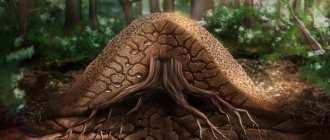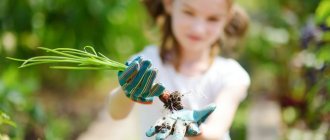External structure
Adult individuals differ from other representatives of the order in the special scaly cover of their wings and the structure of their mouthparts, therefore, first of all, in the 7th grade biology project “Butterflies” it is necessary to disassemble the external structure of the insect:
- the head has a round or oval shape, connected by the occipital part to the chest;
- The chest is divided into 3 segments. The front part is significantly smaller than the middle or back part;
- paws or legs - 3 pairs are located in the back. There are spurs on the shins of the front legs. They are designed to keep the insect's antennae clean;
- abdomen - shaped like an elongated cylinder, consisting of 10 segments and having a ring-shaped structure;
- wings - consist of two pairs. They have the structure of a membrane, which is penetrated by longitudinal and transverse veins. They are covered with flat scales of various shapes. They are modified hairs. Some are equipped with a pigment substance - these are colored scales; some are simply colorless or optical. It is their combination in sunlight that gives the amazing effect of metallic shine. The dimensions of the front and rear wings can be the same or differ in size and shape. The bizarre coloration serves not only as decoration, but also as a protective camouflage, with the help of which the insect is perfectly camouflaged, blending into its surroundings.
The body of the butterfly is protected by a durable chitinous shell. Depending on the species, the size of the insect varies from 2 mm to 31 cm.
Analysis of conducted research
With proper preparation of conditions, the correct temperature and air humidity, a cabbage caterpillar can turn into a butterfly at home. In our case, all the rules for growing a caterpillar into a pupa and a pupa into a butterfly were followed.
To our surprise, only one butterfly was able to hatch, although after the pupation of three caterpillars, two were moving. Most likely, due to late hatching and lack of food, the butterfly did not survive. Also, at some point during the feeding of the adult, the butterfly stuck to the syrup and slightly damaged its wing, this could also be the cause of death. A butterfly cannot exist without wings and flight.
We believe that the goal of the research has been achieved. We managed to grow a butterfly from a caterpillar; we went through the entire stage, observing the complete transformation of this insect. However, we were only able to hatch one butterfly. Three caterpillars were able to pupate, two of them moved, but only one was able to turn into a butterfly.
The research problem—growing conditions—has been solved. We were able to create the conditions for the complete transformation from caterpillar to butterfly. However, we did not have enough skills and knowledge to understand why one of the three pupae was able to turn into a butterfly.
Vision, smell, hearing
In addition to the external structure, 7th grade students are advised to pay attention to the structure and functioning of other important organs of the insect in a biology presentation about butterflies.
Organs of an adult:
- The oral apparatus is a proboscis twisted into a spiral. It is formed from unconnected lower jaws, or rather, their blades. Depending on the species, it may be of the gnawing or sucking type.
- The eyes are large, hemispherical, of complex structure, consisting of many facets, each of which resembles a miniature eye individually. They come in brown, red, yellow, orange or white. The butterfly's eyes occupy a large area of the head. Color vision. The butterfly clearly sees only moving objects, and perceives motionless ones much worse. Some representatives have additional eyes that are located behind the antennae. They are called parietal.
- The antennae are located on the border of the frontal and parietal parts. Their structure and length depend on the type of insect. Thanks to the antennae, the butterfly is perfectly oriented in space, distinguishes odors, and detects even the slightest fluctuation in the wind.
Butterflies have excellent hearing. They are able to detect even barely noticeable ultrasound. The sense of smell works great. And the sense of taste is so developed that they are able to sense even a very weak concentration of sugar. These organs are 2 thousand times more efficient than human organs. Butterflies can also taste food not only with their proboscis, but even with their paws.
Benefits and harms
For agriculture, butterflies bring both benefits and harm. At the caterpillar stage they are undoubtedly pests. At this time, insects are capable of destroying a significant part of the crop, as they feed mainly on the leaves of fruit trees.
In addition, butterflies are dangerous during mass reproduction. To prevent the complete destruction of the crop, gardeners begin to actively fight, usually resorting to various methods.
Adult butterflies bring great benefits by pollinating plants. Particularly prized species are the silkworm, which is capable of producing high-quality silk.
In addition to the topic “Butterflies,” the biology program suggests preparing a presentation about fleas for 7th grade lessons.






